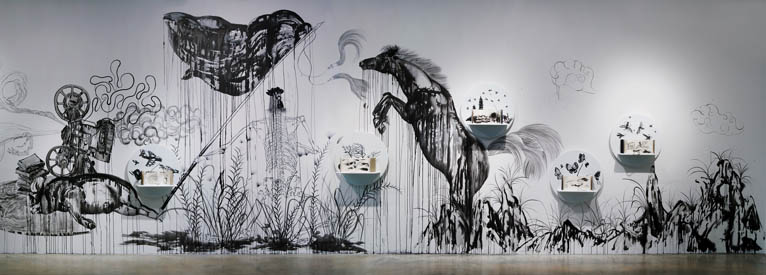SUN XUN: ANIMALS
| February 1, 2010 | Post In LEAP 1

If humans like to impose some measure of harmony upon the natural world—whether by representing animals together in paintings, or by forcibly keeping them separate in zoos—Sun Xun’s recent show at Max Protetch Gallery, titled “Animals,” renounces any such aspirations for idyll. Rather, a sense of menace imbues Sun’s menagerie of horses, crows, butterflies, pigs and turtles. Rendered in ink and watercolor, the critters live out their lives in various media: accordion-fold books, light boxes, film and a giant wall installation comprising ink painting and paper-cut silhouettes. Interspersed among these creatures are images of globes, guns, nuclear blasts and other detritus from the human world.
It’s no shock to learn that British author George Orwell’s Animal Farm inspired this newest body of work, which Sun created as an artist in residence at the University of Essex. The first page of one of his fold-out books reads “renmin caotu,” or “a sketch of the people,” suggesting that the creatures on view, like their counterparts in Animal Farm, are stand-ins for humanity. Luckily, Sun’s art taps into numerous other iconographies, so viewers are spared a ponderous one-to-one mapping of Sun’s subjects onto Orwell’s anti-collectivist narrative. Over and over, the ink and wash technique of the images on view evokes classical Chinese painting. And a scene in the film portrays a map of fictional constellations, calling to mind zodiac characters. These associations enrich the show’s symbolism with ambiguity; one finds oneself in the thick of unsolvable rebuses and vague omens.
Of course, any art depicting a nuclear mushroom cloud can hardly be called upbeat, but the show gets its fanciful yet ominous tone from more than its literary content. Whereas the elements of classical Chinese paintings were arranged for their compositional balance, Sun’s animals often seem purposefully laid out in simple, disorderly rows. In People’s Republic of Zoo Light Box #7, an iris is represented in what is clearly a classical ink and wash style. But the flower occupies a space precariously close to the left side of the composition, one petal even pushing against the edge of the frame. Scale also becomes chaotic: ten birds don’t even begin to add up to the size of the exhibition’s gargantuan crab. Meanwhile, traces of ink drips appear disruptively throughout the wall installation, suggesting conflict even between materials—in the pairing of paint with an incompatible, unabsorbent surface.
In light of these considered formal choices and Sun’s singular painting style, the works are certainly precious as objects unto themselves. Yet the pieces, however autonomous, seem ultimately to exist in service of the allegorical world they depict—just as Sanrio lunch boxes and t-shirts (forgive the Pop analogy to a very un-Pop show) have value only insofar as they tap into the imaginary world of Hello Kitty and her pals. In Sun’s case, several of the paper works on view are artifacts of his animations. Even the works’ titles, all numbered instances of “The People’s Republic of Zoo,” seem to imply that each work is part of a larger whole.
Perhaps Sun’s perspective relates to the fact that he is a frequent inhabitant of the film world, where objects, whether reels or DVDs, are less apt to be fetishized. The artist first began making animations while studying printmaking at the China Academy of Art in Hangzhou. After founding Pi animation studio in 2006, he’s shown his work as often in film festivals as in museums and galleries. One wonders if his role as a filmmaker frees him to take what seems like a slightly sly, playful stance vis-à-vis the art world—in particular, with regard to his choice of subject matter. Arguably, both the supply and demand for portraiture and figuration in contemporary Chinese art have increased in recent years. Sun’s omission of human subjects, short of a skeleton here and there, seems almost a perceptive rebuff of the outside world’s recent hunger for Chinese art that utilizes Chinese faces to answer the question: “Who are we now?”
In considering Sun’s unique approach to exploring nation and identity, it’s perhaps interesting to compare his work to that of American artist Kara Walker—coincidentally, an alumna of New York’s Drawing Center, where Sun had a show earlier last year. Their oeuvres are of course vastly different. But both Walker and Sun aim to tackle the weighty histories of their respective nations and both do so indirectly, from behind a cacophonous, explosive tableau of life. In such oblique gestures, Sun’s show is at its strongest. (In contrast, his overtly geopolitical content comes off a bit flat-footed for my tastes: An image of a mushroom cloud struggles to connote much more than its obvious horrors.) Overall, though, the critiques he offers in “Animals” are nuanced, mindful that things are vastly more complicated than they seem. Dawn Chan


